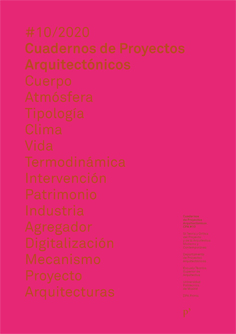Intervenciones termodinámicas: una aproximación a la termodinámica como herramienta de intervención sobre el patrimonio industrial a través del FRAC Nord-Pas de Calais y el Centre Civic Cristalerías Planell = Thermodynamic Interventions: an approach to thermodynamics as a tool for intervention on built industrial heritage through the FRAC Nord-Pas de Calais and the Centre Civic Cristalerías Planell
DOI:
https://doi.org/10.20868/cpa.2020.10.4550Palavras-chave:
Termodinámica, patrimonio, energía, memoria, intervención, Thermodynamics, Heritage, Energy, Memory, InterventionResumo
Resumen
La introducción del concepto de entropía en la arquitectura permite entender el profundo vínculo que hay entre la degradación de la energía y la degradación de la materia, bifurcando la atención hacia el consumo diario de energía de un edificio a lo largo de su vida y hacia el coste energético que implica levantar —o reparar— la propia construcción. En definitiva, dos enfoques para entender el impacto de la construcción sobre el medio. El primero, nos habla de aquella arquitectura que utiliza las energías libres que proceden del aprovechamiento de las variables climáticas como herramientas de diseño. El segundo se refiere a esa arquitectura que, en sus distintas variantes, recupera el patrimonio construido. La reflexión que aquí se plantea pasa por hibridar ambos enfoques de entender el impacto de la construcción sobre el medio, aproximándose a la intervención sobre el patrimonio construido a partir del empleo de principios termodinámicos. Para ello, se apoya en el análisis de dos intervenciones contemporáneas consideradas como paradigmáticas que operan sobre piezas del patrimonio industrial transformándolas para usos culturales. A diferencia de los habituales criterios de intervención basados principalmente en el léxico, el contexto o el programa, estas obras reflejan una forma de recuperar el patrimonio desde premisas de diseño fundamentadas en intercambios de energía con la atmósfera del entorno próximo y abiertas al cambio. Ambas, en cierto modo, son una forma de entender la arquitectura como esa “dialéctica del cambio entrópico” de la que hablaba Robert Smithson. Así, desde un dualismo material y conceptual que aúna presente y pasado, energía y memoria, ambas intervenciones generan imágenes memorables. En última instancia, su estética, basada en el ensamblaje, la hibridación y la contraposición, tanto a nivel energético como material y formal, busca hacer visibles las tensiones y dificultades inherentes al paso del tiempo por arquitecturas pasadas.
Abstract
The introduction of the concept of entropy in architecture has brought to light the tight bond that exists between the degradation of energy and the degradation of matter, shifting the focus to the daily energy consumption of a building during its lifespan, as well as to the cost, in energy terms, of constructing —or repairing— that particular building. In short, it has given way to two different approaches to understanding the impact of construction on the environment. The first approach refers to the kind of architecture that uses free energies generated from an efficient use of climate variables as a design tool. The second approach refers to the kind of architecture that, in its different variants, chooses to restore built heritage. The purpose of this article is to hybridise these two approaches to the impact of construction on the environment by examining architectural intervention on built heritage through the lens of thermodynamic principles. To this end we will review two contemporary interventions that have paradigmatically transformed old industrial buildings into new cultural premises. Far from applying standard intervention criteria, largely based on architectural language, context or programme, these restoration works follow design premises that are founded on energy exchanges with the neighbouring environment, and that are open to change. In a way, both exemplify how architecture can be understood as a “dialectics of entropic change”, as coined by Robert Smithson. From a stance of material and conceptual dualism that blurs the lines between past and present, energy and memory, both interventions generate memorable images. Their outward appearance, based on assemblage, hybridisation and contrast, both in terms of energy, form and matter, ultimately seeks to showcase the tensions and challenges inherent to the passing of time in architecture.
Downloads
Referências
ÁBALOS, Iñaki, y SENTKIEWICZ, Renata. Ensayos sobre termodinámica, arquitectura y belleza. Barcelona: Actar, 2015.
BORASI, Giovanna. y ZARDINI, Mirko. Sorryout of gas. Architecture´s response tothe 1973 oil crisis. Montreal: Canadian Centre forArchitecture, 2007.
CAPITEL, Antón. Metamorfosis de monumentos y teorías de la restauración. Madrid: Alianza, 2009.
FERNÁNDEZ-GALIANO, Luis. El fuego y la memoria. Madrid: Alianza Forma, 1991. FOLCH, Ramón. Ambiente, emoción y ética. La cultura de la sostenibilidad. Barcelona: RBA libros, 2012.
GARCÍA-GERMÁN, Javier. De lo mecánico a lo termodinámico. Por una de noción energética de la arquitectura y el territorio. Barcelona: Gustavo Gili, 2010.
KWINTER, Sanford. “A materialism of theincorporeal” en Documents ofarchitecture and theory 6, 85-89. Nueva York: University of Columbia, 1997.
LINAZASORO, Jose Ignacio. Escrito en el tiempo. Pensar la arquitectura. Buenos Aires: Nobuko, 2003.
MARGALEF, Ramón. La biosfera: entre la termodinámica y el juego. Barcelona: Omega, 1980.
MOE, Kiel. Insulatingmodernism. Isolated and nonisolatedthermodynamics in architecture. Zurich: Birkhauser, 2014.
PRIETO, Eduardo. Historia Medioambiental de la Arquitectura. Madrid: Cátedra, 2019.
VV.AA. El Croquis 202, HArquitectes, 2020.
VV.AA. El Croquis 177-178, Lacaton & Vassal, 2015.
Downloads
Publicado
Edição
Secção
Licença
1. Los autores conservan los derechos de autor y garantizan a la revista el derecho de una Licencia Creative Commons Atribución-NoComercial-SinDerivar 4.0 Internacional que permite a otros compartir el trabajo con un reconocimiento de la autoría.
2. Los autores pueden establecer por separado acuerdos adicionales para la distribución no exclusiva de la versión de la obra publicada en la revista (por ejemplo, situarlo en un repositorio institucional o publicarlo en un libro).












